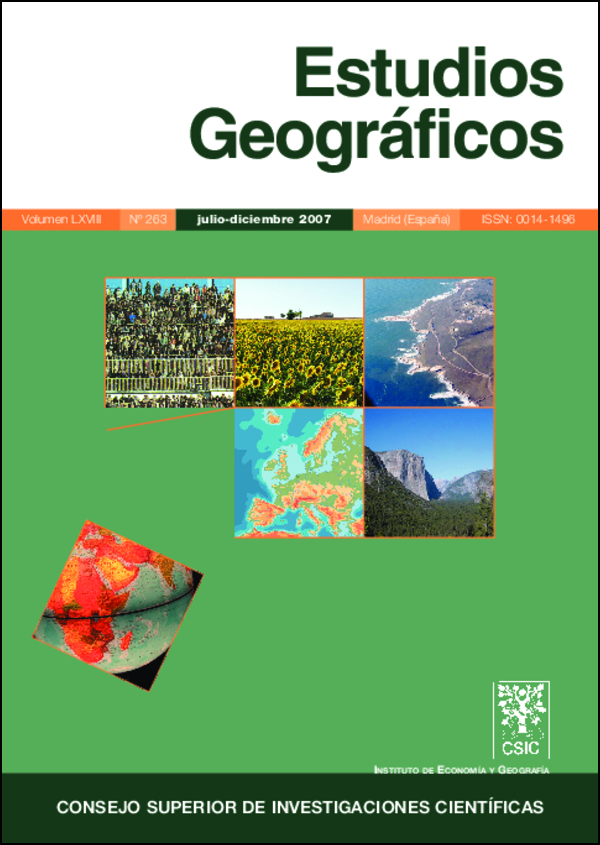“Brain drain” migration in the Magreb region
DOI:
https://doi.org/10.3989/egeogr.2007.i263.64Keywords:
North African migration into de EU, Qualified migrants, “Brain drain”, International migration socio cultural derivativesAbstract
This paper addresses the “brain drain” side of the contemporary migration of peoples from the Magreb region to the European Union and, more specifically to France. The measurement device is the documentation published by UNESCO and EUROSTAT on foreign college level students in EU countries.
Magreb countries are well above the world average in terms of university students abroad over total university students. This fact has both positive and negative consequences for the socioeconomic development of the sending countries. The paper analyses several of them, focusing on the advantages of transnational networks.
The analysis is taken from a dual point of view, European and North African as well. Discrepancies are not erased, since the authors believe that there is not overall consensus on the outcomes of the “brain drain” process that is taking place since several decades by now.
Downloads
References
Ancel, J., 1938. Géographie des frontières, Paris, Librairie Gallimard.
Cebrián, J. A., Bodega, M. I. y López Sala, A. M., 2004. “Twenty years of immigration to Spain, a review”, Revista Cooperación Internacional, n. 10, pp. 53-70.
Bodega, M. I., Cebrián, J. A. y Martín Lou, M. A., 2006. “El crecimiento de la población extranjera en Madrid. Un episodio característico de la inmigración internacional en la España del cambio de siglo”, Estudios Geográficos, LXVII, 261, pp. 385-416.
Charef, M., 1999. La circulation migratoire marocaine: un pont entre deux rives, Agadir, Editions Sudcontact.
Charef, M. y Gonin, P., 2005. Emigrés-Immigrés dans le développement local, Agadir, Editions Sudcontact.
EUROSTAT, 2005. Anuario de Eurostat.
EUROSTAT, 2006a. “Long-term population projections at national level”, Statistics in focus, Population and Social Conditions, 3/2006, European Communities.
EUROSTAT, 2006b. “Non-national populations in the EU Member States”, Statistics in focus, Population and Social Conditions, 8/2006, European Communities.
Gaillard, J. y Gaillard, A.M., 1998. “Fuite des cerveaux, retours et diasporas”, Revue Futuribles, nº 228, pp. 25-49.
Hallary, C., 1994. Les exilés du savoir: les migrations scientifiques internationales et leurs mobiles, Paris, l’Harmattan.
Meyer, J.B. y Brown, M., 1999. Scientific diasporas: A new approach to the brain drain, Discussion Paper No. 41, Budapest, Conférence Mondiale sur la Science : UNESCO-CIUS.
Saïd, E.W., 2000. Culture et impérialisme, Paris, Fayard/Le Monde Diplomatique.
United Nations, 2000. Replacement Migration: Is it a Solution to Declining and Ageing Populations?, New York, ESA/P/WP.160
Downloads
Published
How to Cite
Issue
Section
License
Copyright (c) 2007 Consejo Superior de Investigaciones Científicas (CSIC)

This work is licensed under a Creative Commons Attribution 4.0 International License.
© CSIC. Manuscripts published in both the print and online versions of this journal are the property of the Consejo Superior de Investigaciones Científicas, and quoting this source is a requirement for any partial or full reproduction.
All contents of this electronic edition, except where otherwise noted, are distributed under a Creative Commons Attribution 4.0 International (CC BY 4.0) licence. You may read here the basic information and the legal text of the licence. The indication of the CC BY 4.0 licence must be expressly stated in this way when necessary.
Self-archiving in repositories, personal webpages or similar, of any version other than the final version of the work produced by the publisher, is not allowed.















